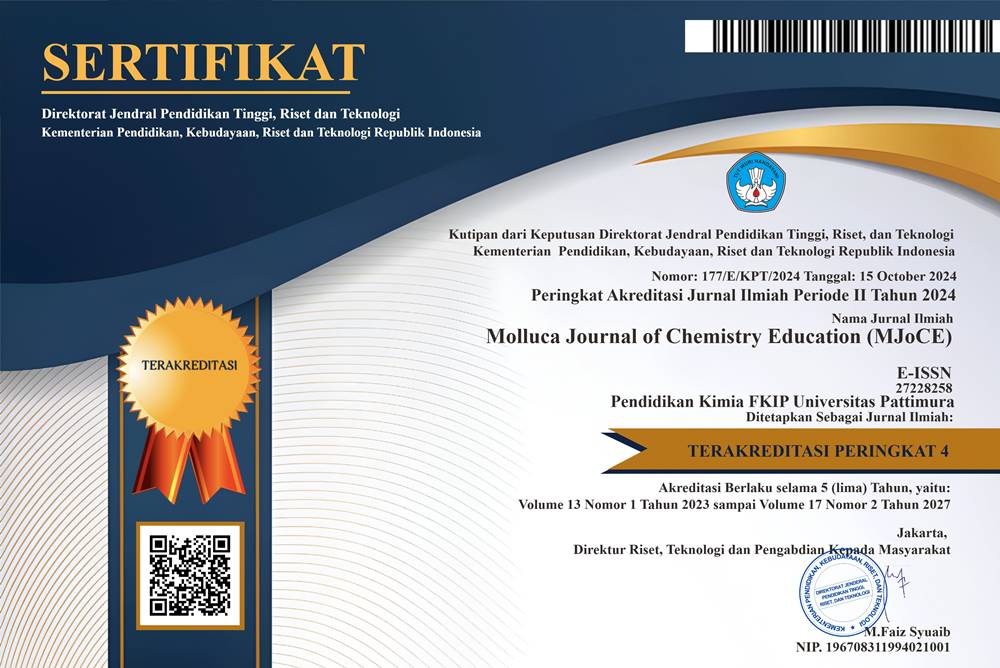ANALISIS SKALA KEMAMPUAN MAHASISWA KIMIA MELALUI TES ENTRY BEHAVIOUR METODE COMPUTERIZE ASSISTED TEST (CAT) MENGGUNAKAN ITEM RESPONS THEORY (IRT)
Abstract
Penelitian ini bertujuan untuk menganalisis Skala Kemampuan Mahasiswa Kimia Melalui Tes Entry Behaviour Metode Computerize Assisted Test (CAT) Menggunakan Item Respons Theory (IRT) Model Logistik 1-Parameter. Subjek penelitian adalah seluruh lembar jawaban peserta Tes Entry Behaviour Mahasiswa Program Studi Pendidikan Kimia Tahun 2019. Penelitian ini merupakan penelitian kuantitatif menggunakan pendekatan ex-post facto. Hasil analisis dengan pendekatan teori tes klasik menunjukkan 79,5% butir memiliki tingkat kesulitan butir berfungsi baik, 57% butir daya bedanya belum memenuhi syarat, dan 72% butir memiliki pengecoh berfungsi baik dengan indeks reliabilitas tes 0,832. Analisis dengan pendekatan teori respons butir menunjukkan terdapat 11 (27,5%) butir soal cocok (fit) dengan model, fungsi informasi maksimum 5,48 pada θ = -0,21, dan besarnya kesalahan pengukuran (SEM) 0,21.
Downloads
References
Allen, M. J. & Yen, W. M. (1979). Introduction to measurement theory. Monterey, CA: Brooks/Cole Publishing Company.
Badrun Kartowagiran, (2006). Teori klasik dan teori respon butir. Bahan Kuliah. Yogyakarta: Pasca Sarjana Universitas Negeri Yogyakarta
Brennan, R. L. (Ed.) (2006). Educational measurement (4thed.). Portsmouth: Greenwood Publishing Group
DeMars, C. E. (2010). Understanding measurement: item response theory. New York: Oxford University Press.
Hambleton, R.K. & Swaminathan, H. (1985). Item response theory. Boston, MA: Kluwer Inc.
Hullin, C. L., et al. (1983). Item response theory: Application to psichologycal measurement. Homewood, IL: Dow Jones-Irwin.
Hambleton, R.K., Swaminathan, H & Rogers, H.J. (1991). Fundamental of item response theory. Newbury Park, CA : Sage Publication Inc
Guilford, JP (1936). Psychometric methods. New York: Mc Graw Hill.
Mehrens, W.A. & Lehmann, I.J. (1973). Measurement and evaluation in education and psychology. New York: Hold, Rinehart and Wiston, Inc.
Nitko, A. J., & Brookhart, S. M. (2007). Educational assessment of students, 5th Edition. Upper Saddle River, NJ: Pearson Education, Inc.
Thorndike, R. M., & Thorndike, C. T. (2010). Measurement and evaluation in psychology and education (8th ed.). Pearson: Upper Saddle River, NJ.
Mislevy, R.J., & Bock, R. D. (1990). BILOG-3 (3nded.): Item analysis and test scoring with binary logistic models. Mooresville, IN: Scientific Software, Inc.
Putri, R. I, Dkk. (2015). Keefektifan Strategi React Ditinjau Dari Prestasi Belajar, Kemampuan Penyelesaian Masalah, Koneksi Matematis, Self Efficacy, Jurnal Riset Pendidikan Matematika, Vol 2, No 2, 262-272
Kubiszyn, T., & Borich, G. (2010). Educational testing & measurement: clashroom application and practice (9th ed.). New York: Jhon Wiley and Sons.





